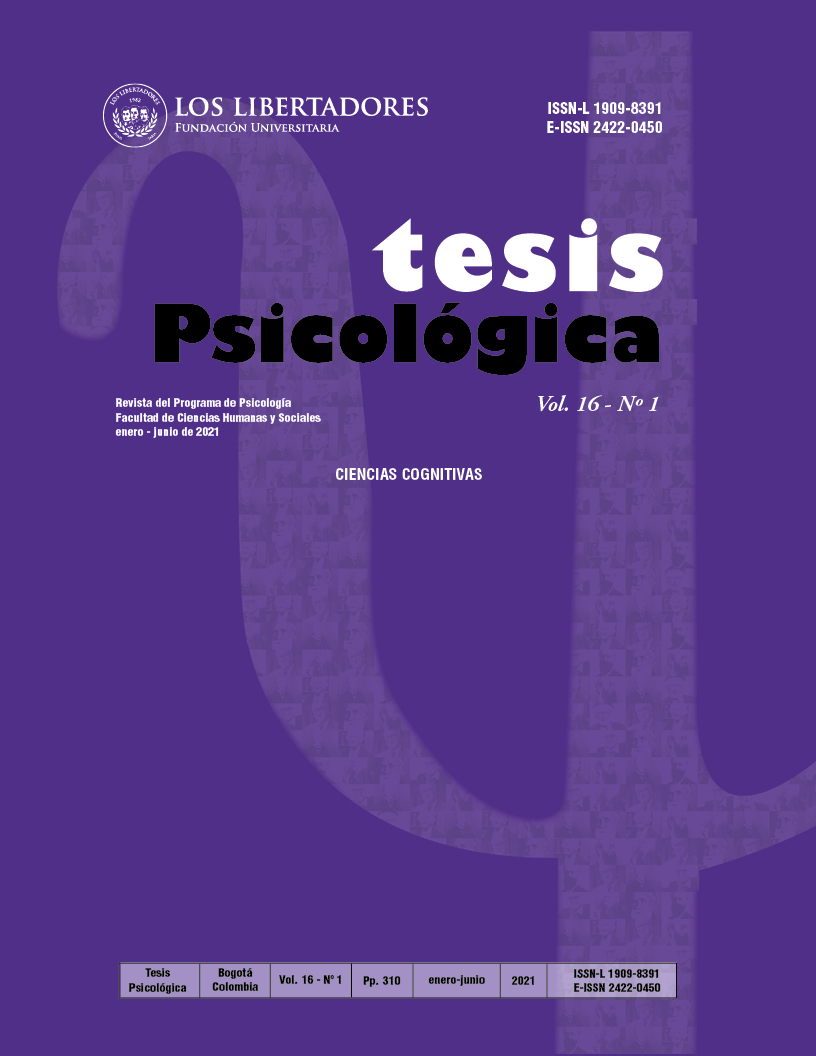Correlación entre trastornos afectivos en padres y el funcionamiento cognitivo de niños y adolescentes en Caldas-Colombia
DOI:
https://doi.org/10.37511/tesis.v16n1a7Resumen
Antecedentes: La depresión, puede afectar el funcionamiento social y emocional de los padres, haciéndolos menos disponibles para sus hijos. Los niños y adolescentes con madres deprimidas tienen mayores alteraciones en la atención, funciones ejecutivas, memoria de trabajo y toma de decisiones, con impacto a nivel socioemocional y escolar. Objetivo: evaluar la relación entre los trastornos afectivos en cuidadores principales y el funcionamiento cognitivo en niños y adolescentes. Metodología: Investigación de tipo descriptivo correlacional, de carácter transversal. Muestra: 171 niños y adolescentes del programa Manizales Elige la Vida, con sus padres o cuidadores: 120 con dificultades afectivo-comportamentales y 51 sin estas dificultades. Instrumentos: PHQ-9 para cuidadores y protocolo de evaluación adaptado de la evaluación neuropsicológica infantil (ENI), Trail Making test y prorrateo de la escala de inteligencia WISC-IV. Resultados: 39% de los cuidadores presentaron síntomas depresivos agudos. En cuanto a la correlación entre depresión en cuidadores (medidos con el PHQ-9) y las variables de las pruebas neuropsicológicas de los niños, se encontró asociación significativa entre alteraciones en funciones atencionales, ejecutivas y de rendimiento cognitivo: Dígitos en regresión (p= 0,0022), TMT-A (p= 0,024) y Cancelación de letras (p= 0,024) Conclusiones: Se encontró asociación entre síntomas depresivos agudos en cuidadores, y alteración de la atención y funciones ejecutivas en niños, así como también, una asociación entre rendimiento cognitivo del niño y antecedentes de familiares con trastornos afectivos.
Descargas
Referencias
Agha, S., Zammit, S., Thapar, A., & Langley, K. (2017). Maternal psychopathology and offspring clinical outcome: a four-year follow-up of boys with ADHD. European Child and Adolescent Psychiatry, 26(2), 253–262. https://doi.org/10.1007/s00787-016-0873-y
Arango-Lasprilla, J. C., & Rivera, D. (2015). Neuropsicología en Colombia: datos normativos, estado actual y retos a futuro. Manizales-colombia: Editorial UAM.
Arango-Lasprilla, J. C., Rivera, D., & Olabarrieta-Landa, L. (2017). Neuropsicología infantil. Bogota: Manual Moderno.
Ardila, A., & Ostrosky, F. (2012.). Guía para el diagnóstico neuropsicológico.Universidad de Guadalajara. Recuperado de: http://ineuro.cucba.udg.mx/libros/bv_guia_para_el_diagnostico_neuropsicologico.pdf
Braungart-Rieker, J. M., Planalp, E. M., Ekas, N. V., Lickenbrock, D. M., & Zentall, S. R. (2020). Toddler affect with mothers and fathers: the importance of infant attachment. Attachment & human development, 22(6), 668-686. doi.org/10.1080/14616734.2019.1681012
Brummelte, S., & Galea, L. A. M. (2010). Depression during pregnancy and postpartum: Contribution of stress and ovarian hormones. Progress in Neuro-Psychopharmacology and Biological Psychiatry, 34(5), 766–776. https://doi.org/10.1016/j.pnpbp.2009.09.006
Cassiani-Miranda, C. A., Vargas-Hernández, M. C., Pérez-Aníbal, E., Herazo-Bustos, M. I., & Hernández-Carrillo, M. (2017). Confiabilidad y dimensión del cuestionario de salud del paciente (PHQ-9) para la detección de síntomas de depresión en estudiantes de ciencias de la salud en Cartagena, 2014. Biomedica, 37 (0),112–120. https://doi.org/10.7705/biomedica.v37i0.3221
Costa, D., Cunha, M., Ferreira, C., Gama, A., Machado-Rodrigues, A. M., Rosado-Marques, V., … Padez, C. (2020). Self-reported symptoms of depression, anxiety and stress in Portuguese primary school-aged children. BMC Psychiatry, 20(1), 87. https://doi.org/10.1186/s12888-020-02498-z.
De Castro, F., Place, J. M. S., Billings, D. L., Rivera, L., & Frongillo, E. A. (2015). Risk profiles associated with postnatal depressive symptoms among women in a public sector hospital in Mexico: the role of sociodemographic and psychosocial factors. Archives of Women’s Mental Health, 18(3), 463–471. https://doi.org/10.1007/s00737-014-0472-1
De Luca, S. M., Yueqi, Y., DiCorcia, D., & Padilla, Y. (2018). A longitudinal study of Latino and non-Hispanic mothers’ and fathers’ depressive symptoms and its association with parent-child communication. Journal of Affective
Disorders, 227, 580–587. https://doi.org/10.1016/j.jad.2017.10.046
De Oliveira, C. V. R., Rasheed, M., & Yousafzai, A. K. (2019). Chronic Maternal Depressive Symptoms Are Associated With Reduced Socio-Emotional Development in Children at 2 Years of Age: Analysis of Data From an Intervention
Cohort in Rural Pakistan. Frontiers in Psychiatry, 10, 859. https://doi.org/10.3389/fpsyt.2019.00859
Delgado Enríquez, L., Jaramillo Ortegón, D., Nieto Murillo, E., Saldarriaga Toro, G., Giraldo Henao, C., Sanchez López, J., … Orozco Duque, M. (2017). Política pública en salud Mental para Caldas. http://observatorio.saluddecaldas.gov.co/desca/saludm/Política de salud mental de Caldas.pdf
Diaz Cadavid, A. (2009). Diseño estadistico de experimentos. Medellin-Colombia:Editorial Universidad de Antioquia.
Ding, Y. Xu, X., Wang, Z., Li, H., & Wang, W.(2014). The relation of infant attachment to attachment and cognitive and behavioural outcomes in early childhood. Early Human Development, 90(9), 459–464. https://doi.org/10.1016/j.earlhumdev.2014.06.004.
Ertel, K. A., Rich-Edwards, J. W., & Koenen, K. C. (2011). Maternal Depression in the United States: Nationally Representative Rates and Risks. Journal of Women’s Health, 20(11), 1609–1617. https://doi.org/10.1089/jwh.2010.2657
Ferrari, A. J., Charlson, F. J., Norman, R. E., Patten, S. B., Freedman, G., Murray, C. J. L., … Whiteford, H. A. (2013). Burden of Depressive Disorders by Country, Sex, Age, and Year: Findings from the Global Burden of Disease Study 2010. PLoS Medicine, 10(11), e1001547. https://doi.org/10.1371/journal.pmed.1001547
Flouri, E., Ruddy, A., & Midouhas, E. (2017). Maternal depression and trajectories of child internalizing and externalizing problems: The roles of child decision making and working memory. Psychological Medicine, 47(6), 1138–1148. https://doi.org/10.1017/S0033291716003226
Gómez-Restrepo, C., de Santacruz, C., Rodriguez, M. N., Rodriguez, V., Tamayo Martínez, N., Matallana, D., & Gonzalez, L. M. (2016). Encuesta Nacional de Salud Mental Colombia 2015. Protocolo del estudio. Revista Colombiana de Psiquiatría, 45, 2–8. https://doi.org/10.1016/j.rcp.2016.04.007
Goodman, S. H. (2020). Intergenerational Transmission of Depression. Annual Review of Clinical Psychology, 16(1), 213-238. https://doi.org/10.1146/annurev-clinpsy-071519-113915
Grisales-Romero, H., González, D., & Porras, S. (2020). Disability-Adjusted Life Years Due to Mental Disorders and Diseases of the Nervous System in the Population of Medellin, 2006–2012. Revista Colombiana de Psiquiatria, 49(1), 29–38. https://doi.org/10.1016/j.rcp.2018.04.003
Hammen, C. (2018). Risk Factors for Depression: An Autobiographical Review. Annual Review of Clinical Psychology, 14(1), 1–28. https://doi.org/10.1146/annurev-clinpsy-050817-084811
Harwood-Gross, A., Lambez, B., Feldman, R., & Rassovsky, Y. (2020). Perception of Caregiving During Childhood is Related to Later Executive Functions and Antisocial Behavior in At-Risk Boys. Frontiers in Psychiatry, 11(1). https://doi.org/10.3389/FPSYT.2020.00037
Herruzo, C., Trenas, A. R., Pino, M. J., & Herruzo, J. (2020). Study of the differential consequences of neglect and poverty on adaptive and maladaptive behavior in children. International Journal of Environmental Research and Public Health, 17(3), 739. https://doi.org/10.3390/ijerph17030739
Hughes, C., & Devine, R. T. (2019). For Better or for Worse? Positive and Negative Parental Influences on Young Children’s Executive Function. Child Development, 90(2), 593–609. https://doi.org/10.1111/cdev.12915
Ivanova, M. Y., Achenbach, T. M., Dumenci, L., Rescorla, L. A., Almqvist, F., Weintraub, S., … Verhulst, F. C. (2007). Testing the 8-syndrome structure of the child behavior checklist in 30 societies. Journal of Clinical Child and Adolescent Psychology, 36(3), 405–417. https://doi.org/10.1080/15374410701444363
Jensen, S. K. G., Dumontheil, I., & Barker, E. D. (2014). Developmental inter-relations between early maternal depression, contextual risks, and interpersonal stress, and their effect on later child cognitive functioning. Depression and Anxiety, 31(7), 599–607. https://doi.org/10.1002/da.22147
Jiménez, G. (2007). Reseña Prueba: Escala Wechsler de Inteligencia para el nivel escolar (WISC-IV). Avances En Medición, 5, 169–171.
Kessler, R. C., & Bromet, E. J. (2013). The Epidemiology of Depression Across Cultures. Annual Review of Public Health, 34(1), 119–138. https://doi.org/10.1146/annurev-publhealth-031912-114409
Kiernan, K. E., & Huerta, M. C. (2008). Economic deprivation, maternal depression, parenting and children’s cognitive and emotional development in early childhood. British Journal of Sociology, 59(4), 783–806. https://doi.org/10.1111/j.1468-4446.2008.00219.x
Klimes-Dougan, B., Ronsaville, D., Wiggs, E. A., & Martinez, P. E. (2006). Neuropsychological Functioning in Adolescent Children of Mothers with a History of Bipolar or Major Depressive Disorders. Biological Psychiatry, 60(9), 957–965. https://doi.org/10.1016/j.biopsych.2006.03.031
Kupferberg, A., Bicks, L., & Hasler, G. (2016). Social functioning in major depressive disorder. Neuroscience & Biobehavioral Reviews, 69, 313–332. https://doi.org/10.1016/J.NEUBIOREV.2016.07.002
Liu, Y., Kaaya, S., Chai, J., McCoy, D. C., Surkan, P. J., Black, M. M., … Smith-Fawzi, M. C. (2017). Maternal depressive symptoms and early childhood cognitive development: a meta-analysis. Psychological Medicine, 47(4), 680–689. https://doi.org/10.1017/S003329171600283X
Maruyama, J. M., Pastor-Valero, M., Santos, I. S., Munhoz, T. N., Barros, F. C., & Matijasevich, A. (2019). Impact of maternal depression trajectories on offspring socioemotional competences at age 11: 2004 Pelotas Birth Cohort. Journal of Affective Disorders, 253, 8–17. https://doi.org/10.1016/j.jad.2019.03.072
Matute, E., Inozemtseva, O., González, A. L., & Chamorro, Y. (2014). La Evaluación Neuropsicológica Infantil (ENI): Historia y fundamentos teóricos de su validación, Un acercamiento práctico a su uso y valor diagnóstico. Revista Neuropsicología, Neuropsiquiatría y Neurociencias, 14(1), 68–95. https://doi.org/10.1017/CBO9781107415324.004
National Research Council (US) and Institute of Medicine (US) Committee on Depression, Parenting Practices, and the H. D. of C., England, M. J., & Sim, L. J. (2009). Depression in Parents, Parenting, and Children. Washington: National Academies Prees.https://doi.org/10.17226/12565.
Niehaus, C. E., Chaplin, T. M., Turpyn, C. C., & Gonçalves, S. F. (2019). Maternal Emotional and Physiological Reactivity: Implications for Parenting and the Parenting–Adolescent Relationship. Journal of Child and Family
Studies, 28(3), 872–883. https://doi.org/10.1007/s10826-018-01318-z
Nusslock, R., Shackman, A. J., McMenamin, B. W., Greischar, L. L., Davidson, R. J., & Kovacs, M. (2018). Comorbid anxiety moderates the relationship between depression history and prefrontal EEG asymmetry. Psychophysiology, 55(1),10.1111/psyp.12953 .https://doi.org/10.1111/psyp.12953
O’Connor, E. E., Langer, D. A., & Tompson, M. C. (2017). Maternal Depression and Youth Internalizing and Externalizing Symptomatology: Severity and Chronicity of Past Maternal Depression and Current Maternal Depressive Symptoms. Journal of Abnormal Child Psychology, 45(3), 557–568. https://doi.org/10.1007/s10802-016-0185-1
Odgers, C. L., & Jaffee, S. R. (2013). Routine Versus Catastrophic Influences on the Developing Child. Annual Review of Public Health, 34(1), 29–48. https://doi.org/10.1146/annurev-publhealth-031912-114447
Ostrosky-Solís, F., Gómez-Pérez, M. E., Matute, E., Rosselli, M., Ardila, A., & Pineda, D. (2007). Neuropsi Attention and Memory: A neuropsychological test battery in Spanish with norms by age and educational level. Applied Neuropsychology, 14(3), 156–170. https://doi.org/10.1080/09084280701508655
Park, M., Brain, U., Grunau, E., Diamond, A., & Oberlander, T. (2018). Maternal depression trajectories from pregnancy to 3 years postpartum are associated with children’s behavior and executive functions at 3 and 6 years. Archives of Women’s Mental Health, 21(3), 353–363. https://doi.org/10.1007/s00737-017-0803-0
Pinto-Dussan, M., Aguilar-Mejia, O., & Gomez-Rojas, J. (2010). Estrés psicológico materno como posible factor de riesgo prenatal para el desarrollo de dificultades cognoscitivas: caracterización neuropsicológica de una muestra colombiana. Universitas Psychologica, 9(3), 749–759. https://doi.org/ISSN 1657-9267
Richards, J. S., Vásquez, A. A., Rommelse, N. N. J., Oosterlaan, J., Hoekstra, P. J., Franke, B., … Buitelaar, J. K. (2014). A follow-up study of maternal expressed emotion toward children with attention-deficit/hyperactivity disorder (ADHD): Relation with severity and persistence of adhd and comorbidity. Journal of the American Academy of Child and Adolescent Psychiatry, 53(3),311-319 https://doi.org/10.1016/j.jaac.2013.11.011
Richardson, L. P., McCauley, E., McCarty, C. A., Grossman, D. C., Myaing, M., Zhou, C., … Katon, W. (2012). Predictors of persistence after a positive depression screen among adolescents. Pediatrics, 130(6),1541-1548. https://doi.org/10.1542/peds.2012-0450
Roman, G. D., Ensor, R., & Hughes, C. (2016). Does executive function mediate the path from mothers’ depressive symptoms to young children’s problem behaviors? Journal of Experimental Child Psychology, 142, 158–170. https://doi.org/10.1016/j.jecp.2015.09.022
Ronsaville, D. S., Municchi, G., Laney, C., Cizza, G., Meyer, S. E., Haim, A., … Martínez, P. E. (2006). Maternal and environmental factors influence the hypothalamic–pituitary–adrenal axis response to corticotropin-releasing hormone infusion in offspring of mothers with or without mood disorders. Development and Psychopathology, 18(1), 173-194. https://doi.org/10.1017/S095457940606010X
Rosselli, M., Matute, E., & Ardila, A. (2010). Neuropsicología del desarrollo infantil. Ciudad de Mexico: Manual Moderno.
Rosselli Cock, M., Matute Villaseñor, E., Ardila Ardila, A., Botero Gómez, V. E., Tangarife Salazar, G. A., Echevarría Pulido, S. E., … Ocampo Agudelo, P. (2004). Neuropsychological Assessment of Children: a test battery for children between 5 and 16 years of age. A Colombian normative study. Revista de Neurologia, 38(8), 720–731. Retrieved from http://www.ncbi.nlm.nih.gov/pubmed/15122541
Salo, V. C., Schunck, S. J., & Humphreys, K. L. (2020). Depressive symptoms in parents are associated with reduced empathy toward their young children. PLOS ONE, 15(3), e0230636. https://doi.org/10.1371/journal.pone.0230636
Sattler, J. M., Padilla Sierra, G., & Olivares Bari, S. M. (2010). Evaluación infantil. Fundamentos cognitivos. Ciudad de México: Manual Moderno.
Sfelinioti, S., & Livaditis, M. (2017). Association of maternal depression with children’s attention deficit hyperactivity disorder. Psychiatriki, 28(3), 251–258. https://doi.org/10.22365/jpsych.2017.283.251
Sheskin, D. (2007). Handbook of parametric and nonparametric statistical procedures. Whashington. Champman & Hall/CRC.
Syrstad, K. (2017). Maternal Depressive Symptoms and Child Behavior Problems, Moderation by Child Characteristics. Tesis inedita departament of psychology. University of Oslo. Oslo- Noruega. https://www.duo.uio.no/handle/10852/56267
Tucker-Drob, E. M., & Briley, D. A. (2014). Continuity of genetic and environmental influences on cognition across the life span: A meta-analysis of longitudinal twin and adoption studies. Psychological Bulletin, 140(4), 949–979. https://doi.org/10.1037/a0035893
Van der Waerden, J., Bernard, J. Y., De Agostini, M., Saurel-Cubizolles, M. J., Peyre, H., Heude, B., … Thiebaugeorges, O. (2017). Persistent maternal depressive symptoms trajectories influence children’s IQ: The EDEN mother–child cohort. Depression and Anxiety, 34(2), 105–117. https://doi.org/10.1002/da.22552
Van der Waerden, J., Galéra, C., Larroque, B., Saurel-Cubizolles, M.-J., Sutter-Dallay, A.-L., Melchior, M., & EDEN Mother–Child Cohort Study Group. (2015). Maternal Depression Trajectories and Children’s Behavior at Age 5 Years. The Journal of Pediatrics, 166(6), 1440-1448.e1. https://doi.org/10.1016/j.jpeds.2015.03.002
Wu, V., East, P., Delker, E., Blanco, E., Caballero, G., Delva, J., … Gahagan, S. (2019). Associations Among Mothers’ Depression, Emotional and Learning‐Material Support to Their Child, and Children’s Cognitive Functioning: A 16‐Year Longitudinal Study. Child Development, 90(6), 1952–1968. https://doi.org/10.1111/cdev.13071
Yan, N., & Dix, T. (2016). Mothers’ depressive symptoms and children’s cognitive and social agency: Predicting first-grade cognitive functioning. Developmental Psychology, 52(8), 1291–1298. https://doi.org/10.1037/dev0000120
Zambrano Sánchez, E., Martínez Cortéz, J. A., Unalfaro-Rodríguez, C., Metroinerva Reehesa, M., Váurb zquezano, F., Sánchez Aparicio, P., & Alfaro Rodriquez, A. (2018). Correlación entre los niveles de ansiedad en padres de niños con diagnóstico de ansiedad y TDAH, de acuerdo al subtipo clínico. Investigación En Discapacidad, 7(1), 22–29. Recuperado de: https://www.inr.gob.mx/Descargas/revista7/revista07_3.pdf
Zhang, H., Lee, Z. X., White, T., & Qiu, A. (2020). Parental and social factors in relation to child psychopathology, behavior, and cognitive function. Translational Psychiatry, 10(1), 1–9. https://doi.org/10.1038/s41398-020-0761-6
Descargas
Publicado
Número
Sección
Licencia

Esta obra está bajo una Licencia Creative Commons Atribución-NoComercial-













